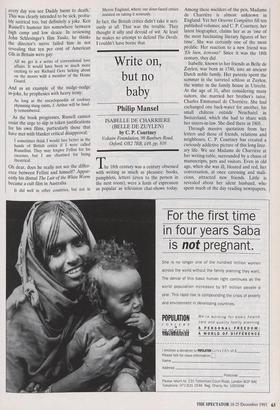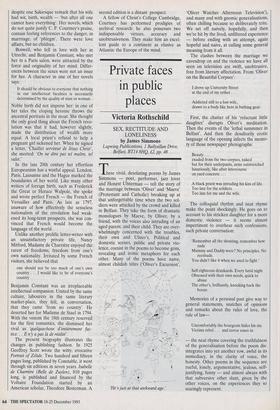Write on, but no baby
Philip Mansel
ISABELLE DE CHARRIERE (BELLE DE ZUYLEN) by C. P. Courtney Voltaire Foundation, 99 Banbury Road, Oxford, OX2 7RB, £49, pp. 810 The 18th century was a century obsessed with writing as much as pleasure: books, pamphlets, letters (even to the person in the next room), were a form of expression as popular as television chat-shows today. Among these wielders of the pen, Madame de Charriere is almost unknown in England. Yet her Oeuvres Completes fill ten published volumes; and C. P. Courtney, her latest biographer, claims her as as 'one of the most fascinating literary figures of her time'. She was certainly one of the most prolific. Her reaction to a new friend was Eh bien, ecrivons!' Since it was the 18th century, they did.
Isabelle, known to her friends as Belle de Zuylen, was born in 1740, into an ancient Dutch noble family. Her parents spent the summer in the turreted schloss at Zuylen, the winter in the family house in Utrecht. At the age of 31, after considering many suitors, she married her brother's tutor, Charles Emmanuel de Charriere. She had exchanged one back-water for another, his small château outside Neuchatel in Switzerland, which she had to share with her sisters-in-law. She died there in 1805.
Through massive quotation from her letters and those of friends, relations and neighbours, C. P. Courtney has created a curiously addictive picture of this long liter- ary life. We see Madame de Charriere at her writing-table, surrounded by a chaos of manuscripts, pets and visitors. Even in old age, when she was ill, bloated and red, her conversation, at once caressing and mali- cious, attracted new friends. Little is revealed about her silent husband, who spent much of the day reading newspapers,
despite one Sakiesque remark that his wife had wit, birth, wealth — tut after all one cannot have everything'. Her novels, which do not quite justify C. P. Courtney's praise, contain feeling references to the danger, in marrriage, of 'phlegm'. There were love affairs, but no children.
Boswell, who fell in love with her in Utrecht, and Benjamin Constant, who met her in a Paris salon, were attracted by the force and originality of her mind. Differ- ences between the sexes were not an issue for her. A character in one of her novels says: It should be obvious to everyone that nothing in our intellectual faculties is necessarily determined by the quality of man or woman.
Noble birth did not impress her: in one of her tales the eloping heroine throws the ancestral portraits in the moat. She thought the only good thing about the French revo- lution was that it had, however slightly, made the distribution of wealth more equal. A local priest's refusal to help a pregnant girl sickened her. When he signed a letter, `Chaillet serviteur de Jesus Christ', she snorted: 'On ne dira pas tel maitre, tel valet.'
In the late 20th century her effortless Europeanism has a wistful appeal. London, Paris, Lausanne and the Hague marked the boundaries of her world. Like many other writers of foreign birth, such as Frederick the Great or Horace Walpole, she spoke and wrote perfect French — the French of Versailles and Paris. As late as 1797, unaware of how effectively the senseless nationalism of the revolution had weak- ened its long-term prospects, she was con- vinced that French would become the language of the world.
Unlike another prolific letter-writer with an unsatisfactory private life, Nancy Mitford, Madame de Charriere enjoyed the rarest of freedoms, freedom from one's own nationality. Irritated by some French visitors, she believed that
one should not be too much of one's own country . . . I would like to be of everyone's country.
Benjamin Constant was an irreplaceable intellectual companion. United by the same culture, labourers in the same literary market-place, they felt, in conversation, that they came 'from no country'. He deserted her for Madame de Stael in 1794. With the venom the 18th century reserved for the first romantics, she dismissed her rival as 'quelquechose d'entierement fac- tice. . Il n' y a pas la de realite.
The present biography illustrates the changes in publishing fashion. In 1925 Geoffrey Scott wrote the witty, evocative Portrait of Zelide. Two hundred and fifteen pages long, published by Constable, it went through six editions in seven years. Isabelle de Charriere (Belle de Zuylen), 810 pages long, is published and financed by the Voltaire Foundation started by an American scholar, Theodore Besterman. A
second edition is a distant prospect.
A fellow of Christ's College Cambridge, Courtney has performed prodigies of archival research: he also possesses two indispensable virtues, accuracy and unobtrusiveness. They make him an excel- lent guide to a continent as elusive as Atlantis: the Europe of the mind.











































































































 Previous page
Previous page